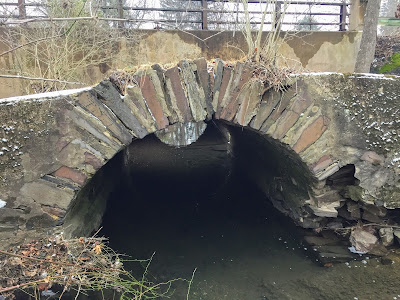Few people driving out Snowden Lane in Princeton will notice this little old bridge. Replaced by a larger bridge in 1965, it still remains, just upstream of the newer one. Why was it not demolished when the new bridge was built? Either they realigned the road for other reasons, or someone felt it special enough to save. Back when this part of town was referred to as "the country", the bridge would have been used frequently by the Veblens to reach their home, by their friends like Einstein to visit, and by members of the Moses Taylor Pyne family to reach their horse farm where Snowden Lane meets Herrontown Road.
I showed it to architectural historian Clifford Zink, and he immediately uttered a German word meaning homemade. A "vernacular bridge!," he declared. He pointed out the narrow ledge running the length of the bridge, at the bottom of the arch on both sides. The ledge had supported the arch-shaped wooden framing, called "centering", upon which the stones had been laid, in such a way that their shapes would keep them in place after the framing was later removed.Saturday, February 26, 2022
A Vernacular Bridge Used by Veblen, Einstein, and Pyne
Friday, February 25, 2022
The Roof That Wasn't -- How the Veblen House Roof Came To Be
One of the stories passed down about Veblen House was that its roof was built separately from the rest of the house. I had assumed that meant that the Whiton-Stuarts had brought the first and second floors from Morristown, then added a roof when the house was reassembled on its current site in Princeton.
Then came a day when a number of us were up in the attic with some knowledge of construction and history--Clifford Zink, Jim Huffman, Peter Thompson--not sure who all. And someone pointed out that the layer of thick tar paper covering the floor looked as if it were the covering for a flat roof. They looked more closely, and found more evidence to that effect.
I had assumed that the flat roof had been a temporary and less than ideal condition soon improved upon by the Whiton-Stuarts during their ten years there in the 1930s. After all, the fixtures used to bolt the roof together closely resembled bolts used elsewhere in the house.The real story was waiting to be found at the Library of Congress in Washington, D.C., in Box 43 of Oswald Veblen's papers, donated after his death. In fact, the real story had been found years ago, and sent to me by Victoria Floor after she spent a couple days going through his papers while visiting a friend there. I recently looked back and read what she'd sent:
Box 43 Herrontown woods file—receipts for minor repairs, roofing Matthews Construction Co, Princeton (feb 28, 1941) ‘TO REMOVE THE PARAPET WALLS AT THE GABLE ENDS OF THE ABOVE HOUSE…THE REMOVAL OF THE RAILING RAILING AND PATCHING…EXPOSED PORTIONS OF THE ROOF CAUSED BY ABOVE ALTERATION…CONSTRUCTION OF A SIMPLE CORNICE…[OTHER ROOFING JOB DETAILS] 1 P.
Our carpenter, Robb Geores said he was "intrigued that parapet walls were removed on the gable ends. Parapet walls are usually a low wall around a flat roof. I would guess that they framed the roof on top of the flat roof. Then removed the parapet walls on the gable ends and then filled them in. There's still a curb up there in the attic. And also what appears to be exterior roofing on the floor. Totally supports the theory."
Robb sent a link from the Princeton Academy website, describing the legacy of the Matthews Construction Company, which built their Manor House. Describing the "quality of the construction and craftsmanship," they described Matthews asby far the most successful construction company in Princeton in the first half of the twentieth century. Their projects include the Nassau Inn and Palmer Square, the Graduate College and most of the Collegiate Gothic buildings on the Princeton campus. Matthews built the Dignan House in 1930 and 1931 at the height of the Depression and the project provided vital labor for the firm’s stonemasons, woodcarvers, and glaziers. During the late 1920s, Matthews constructed the Princeton University Chapel.
The NY Times obituary for Matthews in 1951 states that the firm erected most of the buildings on campus over the course of fifty years.







